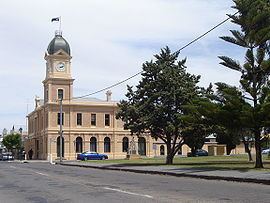Established 1863 State electorate(s) Goyder Founded 1863 Postal code 5558 | Postcode(s) 5558 Mean max temp Mean min temp Elevation 44 m Local time Saturday 10:26 PM | |
 | ||
Population 681 (shared with other localities in the ‘State Suburb of Moonta’) (2011 census) Weather 19°C, Wind E at 18 km/h, 43% Humidity Lga District Council of the Copper Coast | ||
Moonta is a town on the Yorke Peninsula of South Australia, 165 km (103 mi) north-northwest of the state capital of Adelaide. It is one of three towns known as the Copper Coast or "Little Cornwall" for their shared copper mining history.
Contents
- Map of Moonta SA 5558 Australia
- Aboriginal use
- European discovery and use
- Heritage listings
- Geography and climate
- Economy
- Transport
- Governance
- References
Map of Moonta SA 5558, Australia
The centre is about 17 kilometres (11 mi) south west of Kadina, site of Wallaroo Mines, and 14 kilometres (8.7 mi) south of the port of Wallaroo. The name "Moonta" is reportedly derived from munta-muntara or moontera, an Aboriginal word for "thick scrub place" or "impenetrable scrub".
At the 2011 census, the Moonta township and the adjacent suburbs of Cross Roads and Yelta had a combined population of 681. The broader Moonta urban centre, also including Moonta Bay, North Moonta and Port Hughes, had a population of 3,659.
There are 11 suburbs surrounding central Moonta, each being a distinct historic locality or hamlet. These are: Cross Roads, East Moonta, Hamley, Kooroona, Moonta Bay, Moonta Mines, North Moonta, North Yelta, Paramatta, Port Hughes and Yelta.
Aboriginal use
Prior to European settlement, the Moonta area was occupied by the indigenous Narungga people.
European discovery and use
The Yorke Peninsula coastline near Wallaroo was separately navigated by Matthew Flinders and Nicolas Baudin in 1802.
The first Europeans to explore the district were John Hill and Thomas Burr. Under instructions from Governor Gawler, the pair were landed near Moonta Bay on 28 April 1840 from the government cutter Water Witch. They then made their way back to Adelaide on horseback, traversing Northern Yorke Peninsula. They reported the discovery of 'a very excellent tract of country'. Based on that report a few pioneering British settlers arrived in the Moonta area in the 1840s, as pastoralists, but there was no significant development until the 1860s, primarily because of the lack of water. The scrub in the area was difficult to penetrate (as testified by the town's name) so the first settlers had a hard time clearing the land.
Large and rich deposits of copper were discovered at Moonta in 1861 by Patrick Ryan, a shepherd from Walter Hughes' property. This became a prosperous mine, named Wheal Hughes, with other mines soon to follow. The government town of Moonta was surveyed in March 1863, while an informal township of mining workers also grew at Moonta Mines. A horse tramway from Moonta to the port at Wallaroo opened in July 1866. Following advertising by the South Australian Government, Cornish miners arrived in Moonta in large numbers. The mines at Moonta proved to be the richest mines in the whole of South Australia by 1917, exceeding the total wealth created by all other mines since 1836, the year of establishment of South Australia. The population of Moonta in 1875 was 12,000. The main copper mining operations at Moonta Mines ceased in 1923, although a number of smaller mines continued to be worked for some years. Smaller-scale operations recommenced in the area in the late 1980s but had closed by the mid-1990s.
Heritage listings
Moonta has a number of heritage-listed sites listed on the South Australian Heritage Register, including:
Geography and climate
Moonta exists in a semi-arid location, above Goyder's Line. Moonta is surrounded by mallee scrub. The centre is located four kilometres inland and is 20 metres above sea level. Moonta has a dry Mediterranean climate with seasonal temperatures about the same as Adelaide's temperatures. The temperature ranges are similar to those of Kadina and the weather patterns are similar to those of both Kadina and Adelaide.
Following the demise of copper mining, the district successfully merged into dry land farming. Moonta's surrounds are used for growing barley, wheat and other crops such as legumes, canola, chickpeas and field peas. Barley from the region is considered to be some of the best in the world.
Economy
Moonta, the town centre, consists of old limestone miners' cottages and churches, giving the town a historical feel. There are several eateries in the town centre, as well as at Moonta Bay and Pt. Hughes.
The nearby locations of Moonta Bay, Port Hughes and Simms Cove are on the foreshore and are rapidly developing. They are extremely popular locations for retirement and holiday makers. The beaches, with fine white sand, are popular with recreational anglers and sailboarders. The natural state of the coast has largely been retained.
Tourism is a significant local industry, focusing on the availability of beachside accommodation,including several caravan parks, holiday houses, bed and breakfast and a motel.
The National Trust of South Australia operates a number of heritage attractions in adjacent Moonta Mines, including a narrow gauge railway through the former mining works, a museum in the former Moonta Mines Model School, a sweet shop, former mining cottage and surviving buildings associated with the mines.
The former Moonta railway station is now a visitor information centre.
The popular three-day Kernewek Lowender Cornish festival is held every odd year in May in the Copper Coast towns of Moonta, Kadina and Wallaroo, with events staged across the three towns over several days.
Transport
Starting in the 1880s, agitation for conversion of the horse tramway to a steam locomotive railway commenced.
Governance
Moonta is located within the federal division of Grey, the state electoral district of Goyder and the local government area of the District Council of the Copper Coast.
